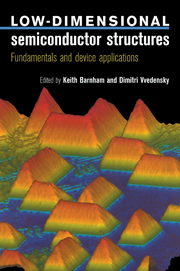Book contents
- Frontmatter
- Contents
- List of contributors
- Preface
- 1 Epitaxial Growth of Semiconductors
- 2 Electrons in Quantum Semiconductor Structures: An Introduction
- 3 Electrons in Quantum Semiconductors Structures: More Advanced Systems and Methods
- 4 Phonons in Low-dimensional Semiconductor Structures
- 5 Localization and Quantum Transport
- 6 Electronic States and Optical Properties of Quantum Wells
- 7 Non-Linear Optics in Low-dimensional Semiconductors
- 8 Semiconductor Lasers
- 9 Mesoscopic Devices
- 10 High-speed Heterostructure Devices
- Solutions to Selected Exercises
- Index
6 - Electronic States and Optical Properties of Quantum Wells
Published online by Cambridge University Press: 06 July 2010
- Frontmatter
- Contents
- List of contributors
- Preface
- 1 Epitaxial Growth of Semiconductors
- 2 Electrons in Quantum Semiconductor Structures: An Introduction
- 3 Electrons in Quantum Semiconductors Structures: More Advanced Systems and Methods
- 4 Phonons in Low-dimensional Semiconductor Structures
- 5 Localization and Quantum Transport
- 6 Electronic States and Optical Properties of Quantum Wells
- 7 Non-Linear Optics in Low-dimensional Semiconductors
- 8 Semiconductor Lasers
- 9 Mesoscopic Devices
- 10 High-speed Heterostructure Devices
- Solutions to Selected Exercises
- Index
Summary
Introduction
Recent progess in epitaxial growth techniques has promoted the use of semiconductor heterostructures in optoelectronic devices. The physics of these materials relies upon the similarity between the electronic band structures of the different semiconductors. If the bulk band structures are sufficiently similar then changes in composition can be represented primarily as changes in the band splittings and other bulk parameters. In a direct band-gap semiconductor an abrupt change in composition from wide to narrow band gap results in a discontinuity in the conduction and valence band profiles in the growth direction. The heterointerface so formed is Type I or Type II, depending on the band-gap alignments, determined by the conduction band offset (Fig. 6.1).
A quantum well (QW) is made by growing a thin layer – typically a few nanometres (nm) or 10s of nm – of narrower gap material within a wider-gap semiconductor, where the inserted layer is thin enough to cause quantum confinement of the carriers. QWs are similarly classified as Type I or II in direct-gap materials (Fig. 6.2).
In indirect gap materials we need to consider the band-edge discontinuities at different points in the band structure. The AlAs/GaAs heterointerface, for example, is Type I at the Г point but Type II at the X point (Fig. 6.3). The overall band structure of an AlAs/GaAs QW system thus depends on the relative well and barrier widths.
- Type
- Chapter
- Information
- Low-Dimensional Semiconductor StructuresFundamentals and Device Applications, pp. 180 - 226Publisher: Cambridge University PressPrint publication year: 2001



